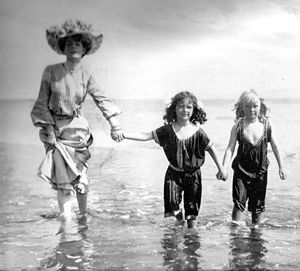Photograph
Introduction
A photograph dipicts 3 stages. In the first stage, the photograph shows the poet's mother standing at the each enjoying her holiday ith her two girl cousins. She was 12 or so at that time. The second stage takes us twenty or thirty years later. The mother would laugh at the way she and her cousins Betty and Dolly were dressed up for each holidays. In the third stage, the poet remembers the mother with a heavy heart. The photograph revives a nostargic feeling in the poet.
Source: Click here
Concept Map
Text of the Poem
To access the text of the poem, click here
Idea of the Poem
Core Meaning
Line-wise summary:
1) The cardboard (photograph) shows the narrator's mother.It was a piture when she was young. (poetic device: allusion as the cardboard’s lack of durability hints at the lack of permanence of human life)
2) When two cousins of her mother went paddling (on the beach, with the narrator’s mother)
3) Both the cousin girls were holding the mother's hands.
4) The poet's mother was the eldest – about twelve years old at the time the photograph was taken.
5) All three of them stood smiling, their hair strewn across their face (possibly tossed by the beach wind or water) (poetic device: alliteration... stood still to smile)
6) As her mother’s uncle clicked their picture with a camera. Her mother’s face was sweet.
7) And the picture was taken much before the narrator was born.
8) The sea in the picture is still the same today (has changed very less)
9) And in the picture the sea is washing their feet which by nature, are transient because human life is short-lived as compared to nature. The nature remains the same for a long time. (Poetic device: Transferred Epithet. Human life itself is temporary not the feet. When the adjective for one noun like life is transferred to another noun like feet, it is called transferred epithet. It is also alliteration due to the repetition of the ‘t’ sound but Transferred Epithet is the dominant device here.)
10) Some twenty or thirty years later from when the picture was clicked,
11) her mother had looked at the snapshot and laughed. She had pointed out her cousin Betty and Dolly and talked nostalgically of how oddly they used to be dressed for the beach. The sea holiday was remembered by her mother with a fondness as well as a sense of loss. That is because that time would never return.
12) Similarly, her laughter would never return to the narrator. The sea holiday was the narrator’s mother’s past and her mother’s laughter is the narrator’s past.
13) Both these pasts, the sea holiday as well as the laughter of her mother are remembered with a difficult and yet easy sense of loss. (Poetic device: oxymoron. The coming together of two opposite ideas to describe the same entity. ‘Laboured’ and ‘easy’ are opposite words describing the same entity ‘loss’. The loss of the holiday and the laughter was easy because these things have to be accepted as a part of life. They are merely a part of the past and cannot be brought back or relived. However, precisely because they cannot be relived, there will always be a tinge of difficulty letting them go completely. They will always be seen as loss.)
14) Now, it has been twelve years since her mother passed away. The girl in the photograph seems like a different person altogether. Thus, the use of the words, ‘that girl’.
15) And about the fact that her mother has passed away leaving behind nothing but memories and photographs like this one,
16) there is nothing to be said. It is a part of life and on thinking of it, one really has no words to express how one feels.
17) The silence of the whole situation silences the poet and leaves her quiet. (poetic device: alliteration and personification. The situation has been given the human quality of silence and the sound of ‘s’ has been repeated)
The camera thus managed to capture a moment in time. It kept the memory of the mother and for the mother alive. The sea holiday brought a sad smile (wry) to the mother’s face because she couldn’t relive it but was glad that she once had. Similarly, thinking of her mother’s laughter brought a sad smile to the poet’s face because although that laughter was now gone she was glad to have once had it in her life.
Nature is perennial while human life is temporary or transient. The poet uses a transferred epithet (terribly transient feet) in order to make this comparison and highlight the terribly short-lived life of her mother.
As in the Portrait of a Lady, this poem also deals with the theme of loss and bereavement and the impact it leaves on those who are left behind.
Source: Click http://liveenglish11.blogspot.in/2012/07/detailed-explanation-photograph-by.html here]
